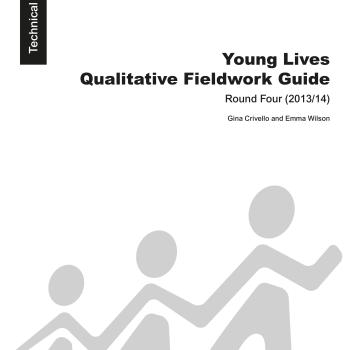
Children are at the heart of Young Lives, and this fieldwork guide describes a set of tools that were developed to work with children involved in the longitudinal qualitative research component of the study. The manual guided the fourth round of data collection in 2013/14, which took place between the fourth and the fifth rounds of the household and child survey. In this round of research, we sought to document changes since the previous rounds of qualitative research (in 2007, 2008, and 2010-11), and to understand how poverty interacts with other social factors – such as gender, generation, and ethnicity – to shape their differing trajectories over time. Our research questions are relevant for both age groups, but each are experiencing different transitions – as the Younger Cohort reach early adolescence, and the Older Cohort are in transition from adolescence and into early adulthood (and some become parents themselves).
This fieldwork guide was produced collaboratively by an international team of researchers taking part in the Young Lives study. Our hope is that the methodology and tools can be carefully adapted and used by other researchers in an effort to encourage the participation of children in social research. It should be read along with our introductory ‘Guide for Researchers’ and separate guides for each earlier round of qualitative research.

Children are at the heart of Young Lives, and this fieldwork guide describes a set of tools that were developed to work with children involved in the longitudinal qualitative research component of the study. The manual guided the fourth round of data collection in 2013/14, which took place between the fourth and the fifth rounds of the household and child survey. In this round of research, we sought to document changes since the previous rounds of qualitative research (in 2007, 2008, and 2010-11), and to understand how poverty interacts with other social factors – such as gender, generation, and ethnicity – to shape their differing trajectories over time. Our research questions are relevant for both age groups, but each are experiencing different transitions – as the Younger Cohort reach early adolescence, and the Older Cohort are in transition from adolescence and into early adulthood (and some become parents themselves).
This fieldwork guide was produced collaboratively by an international team of researchers taking part in the Young Lives study. Our hope is that the methodology and tools can be carefully adapted and used by other researchers in an effort to encourage the participation of children in social research. It should be read along with our introductory ‘Guide for Researchers’ and separate guides for each earlier round of qualitative research.

